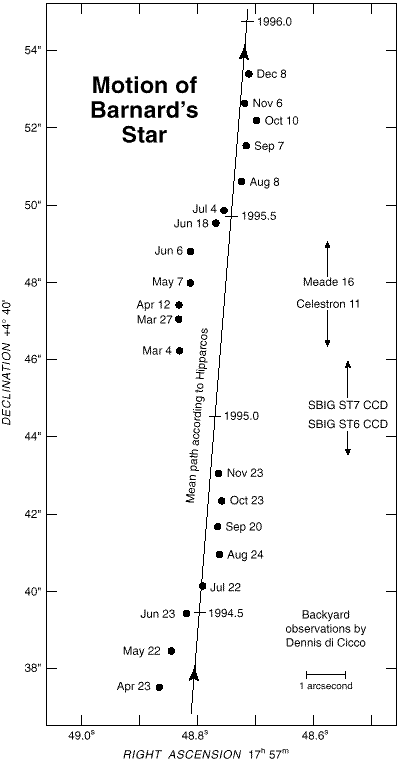High Proper Motion Stars - Hipparcos
High Proper Motion Stars |
|
| In addition to the coordinates of the stars, Hipparcos also measured the movement of stars: their proper motion. Most stars are so distant that their apparent motion even over hundreds of years is all but negligible to naked eye observers. The proper motions of all stars in the Hipparcos Catalogue are tabulated. Some stars have very significant movements compared to the background stars, and these are referred to as 'high proper motion stars'. Barnard's star (HIP 87937) has the greatest proper motion; the Hipparcos measurements give: proper motion in right ascension = -797.84 mas/yr proper motion in declination = 10326.93 mas/yr giving a total proper motion = 10357.704 mas/yr Check the Hipparcos Catalogue for more information on the notation. The units of the proper motion for all stars in the Hipparcos and Tycho Catalogues is mas/yr (or milliarcseconds per year). The same number gives the angular distance that the star would move, in seconds of arc, in one thousand years. The figure (also available as a pdf file) is taken from the introduction to The Millennium Star Atlas, and was produced by Dennis di Cicco for Sky Publishing Corporation. Note that proper motion of the star stands out clearly as a movement of the star against the background stars with time. Dennis di Cicco's observations were so accurate that the effect of the parallax (the distance) of the stars is also evident. It is seen as the "wavy" motion of the star (the individual observations are shown as black circles with the relevant observation date) about its linear motion (shown as the straight line dissecting the figure); this wavy motion has a period of one year, corresponding to the Earth's orbital motion around the Sun. |
 |
- Removed a total of (2) align=top;
- Removed a total of (1) border attribute.
- Removed a total of (1) cellpadding attribute.
- Removed a total of (1) cellspacing attribute.








































 Sign in
Sign in
 Science & Technology
Science & Technology